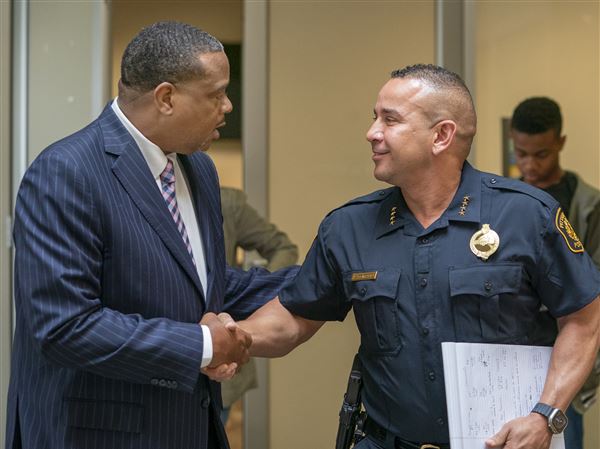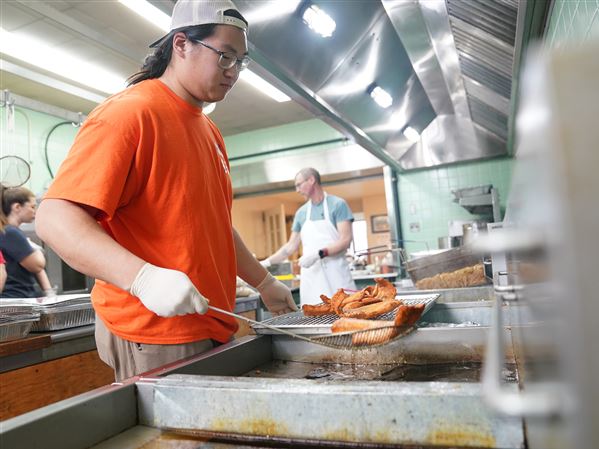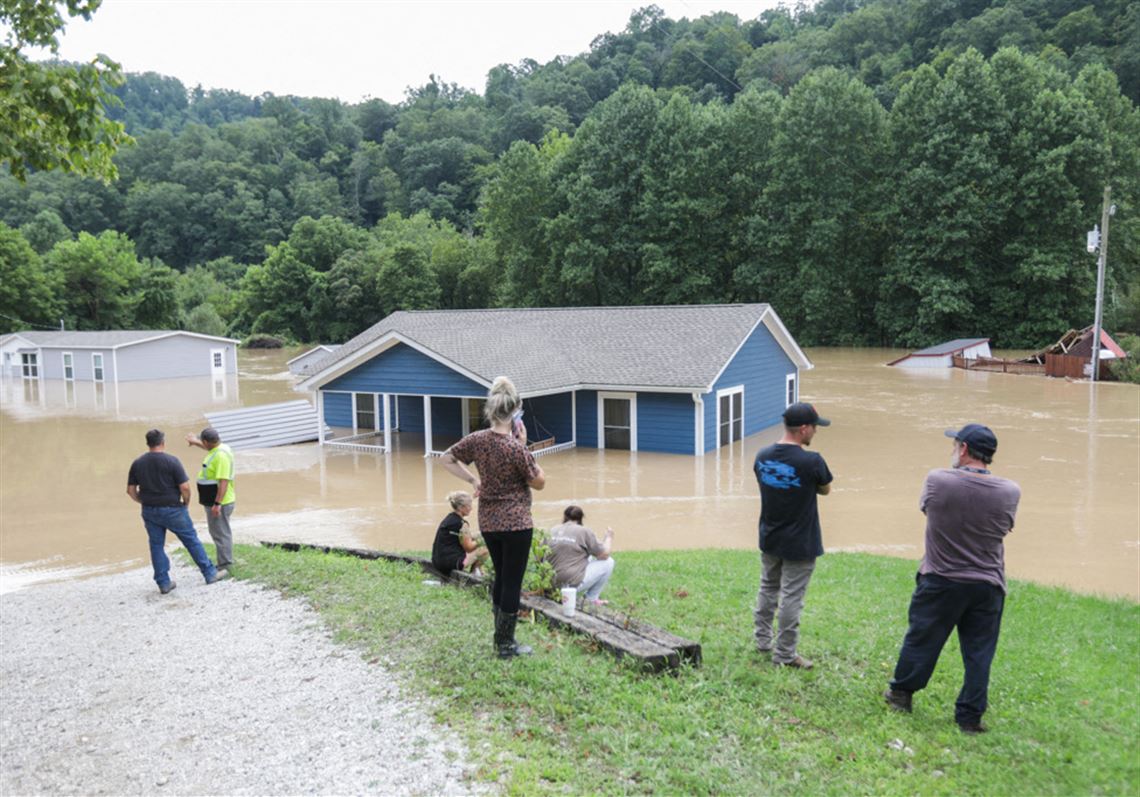In the picture, 98-year-old Mae Amburgey sits atop her bed as floodwaters rise on every side, four feet deep in her Letcher County, Ky., home. Her legs are submerged in the cold, muddy water as she watches the flood pour in around her, destroying everything she owns. There is a strange calm about her posture — arms wrapped elegantly about her knees, a strength in her shoulders even in this moment of utter defeat — but her face is shaped by concern and grief. Her granddaughter posted the picture in the hopes that someone seeing it would rescue “Mom Mae” and two other relatives.
Not far away, near the small town of Whitesburg, 17-year-old Chloe Adams had awakened to her family’s home being overtaken by water. She knew that if she didn’t escape she’d drown. Chloe grabbed only her dog, Sandy, and swam out. The teenager hoped to make it to her uncle’s house on higher ground, where the rest of her family was sheltering, but the water was too deep and rough, so she and Sandy waited for five hours on the narrow roof of a shed that was almost completely submerged before she was rescued in a kayak. In a photo that would eventually be seen by multitudes, she looks into the camera with exhaustion, but her determination is intact. Sandy rests securely on Chloe’s aching legs.
As someone from eastern Kentucky whose family lost nearly everything to a flash flood when I was a child, I was rushed back in time to that cold day when my mother and I escaped our house trailer as it was being engulfed by roiling waters. My family was safe this time, but the complex place I love was not; Appalachia was pummeled once again. The Hindman Settlement School, a center for the literary arts, foodways and dyslexia programming where I often teach, saw its offices, archives and many classrooms devastated by the storm that came so fast there was no time to save anything. Participants in a writing workshop there had to flee their dormitories in the middle of the night to seek higher and more stable ground, fearing the rising water and mudslides. Many Appalachian people have had this experience. But now it’s happening much more often. We are all victims of climate change.
Americans’ responses to the images and stories that came out of the devastating flooding of eastern Kentucky in the early-morning hours of July 28 tended to fall into two camps. One group voiced compassion and joined the relief effort by donating their money or their services. The second fired off tweets of derision (“Let’m swim,” one person wrote), negating people they deemed responsible for voting in the obstructionist senators Mitch McConnell, who has blocked climate change measures and mining regulations for decades, and Rand Paul, who has continually criticized and voted against relief bills to help others, including hurricane victims. “These people got what they voted for,” another commented.
So many in the area have lost their homes, their children, their own lives. But we should also care because science shows that someday soon the same thing may happen to many more of us. We can be better people by imagining ourselves in the most desperate situations of others.
We’re already seeing the climate crisis reshaping American lives. According to the U.S. government, heavy rain events have intensified across most of the country; a warmer atmosphere’s ability to hold more moisture has led to an increase in such precipitation. In eastern Kentucky late last month, nine inches of rain fell in 12 hours. A few days before, St. Louis had record downpours. Meanwhile, our two largest reservoirs, Lake Mead in Nevada and Lake Powell in Utah, both on the Arizona border, are heading toward dead pool status — the point when the water level is so low it can’t flow downstream from the dam. Massive forest fires are devouring parts of California, Idaho, Montana and Hawaii. Scientists agree more than ever that we are experiencing extreme weather caused by climate change.
The people most affected will generally be those who live in the poorest regions of the world, which are also the places that have tended to be the richest in natural resources. The Democratic Republic of Congo has abundant minerals such as diamonds, gold and copper, yet its poverty rate is among the highest in the world. Studies show that petroleum-rich areas such as Iraq and Syria often have less democracy. It behooves the corporations that control these lands to keep the people poor and under their thumbs so they can suck the resources dry with the least amount of interference. The poorer the person, the less power they have to fight back or effect legislative change.
This has always been the case in Appalachia, where we are up against huge businesses and the government but also centuries-old stereotypes that were at least partly born to more easily snatch our natural resources.
Often when I am on book tours, people will ask me why I choose to live in Kentucky. They find it hard to fathom why anyone would want to live in a place that films, TV shows and other media have taught them is a cesspool populated only by slack-jawed yokels. This question reveals classism and ignorance of what it means to be poor or working class, or to have an allegiance to place. Eastern Kentuckians stay for the same reasons people went back to their homes after Hurricanes Katrina and Sandy or the California infernos.
I have a deep pride in being from Appalachia despite an utter frustration at the way the region votes. You can love a place to your bones and still not completely understand it. We are people who have fought for labor rights and the environment for decades. I’m the grandchild of a coal miner who lost his leg to the mines and years later gave his breath to them as well when he died of black lung, like so many others. We’ve fueled this nation with our timber, coal, gas, soldiers, music, literature and more for two centuries. Some of us stay here because we have no other choice; my family didn’t live in the flood plain because we wanted to but because we were poor.
I had to study awhile to figure out why Mae Amburgey seemed so familiar to me. I realized it was because I had seen that same look on my mother’s face when we escaped the flood all those years ago. Hers is the face of so many who have come before her and who will come after, of all people who have had to fight to survive. I’m haunted by the weariness and determination in the eyes of Chloe Adams. Hers are the eyes of so many children from all over the world who are powerless against others’ greed.
They are my people not only because they are Appalachian, like me, but because they are human beings. They are familiar faces because they are all of us, caught in the clutches of entities that have more rights than we do as individuals, including companies that so often get favors from politicians like Mr. McConnell and Mr. Paul. They are ourselves and our children and our grandchildren in the near future; the climate crisis is happening now.
“My heart goes out to all the other people who lost and suffered so much more than I did in this horrific devastation,” Ms. Adams said once she and her dog were safe and dry. Despite being nearly 100 years old, Ms. Amburgey swam out of that house. She was swept by the churning waters into a nearby bridge, but she then made it to the boat of her rescuers.
Tonight, rain is falling across eastern Kentucky once again.
Silas House is the author of seven novels. His latest, “Lark Ascending,” about climate refugees, will be published in September.
First Published: August 14, 2022, 4:00 a.m.
















